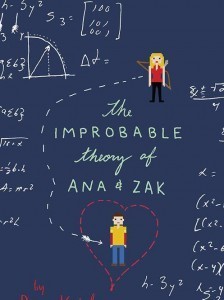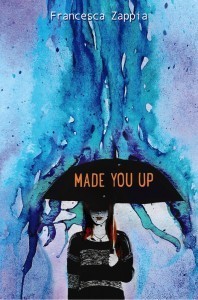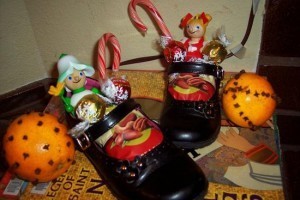Lea Wait's Blog, page 303
December 17, 2014
Thea’s Quick and Dirty Holiday Party
Kate Flora here, still busy doing my homework, way behind on holiday shopping, with nothing
wrapped and no holiday tree. So you won’t be surprised to learn that when I sat down to write a blog 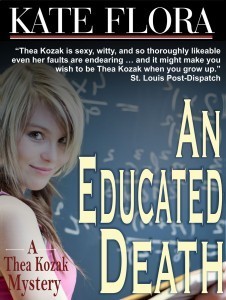 post, I came up kind of empty. Childhood Christmas, I thought. Dug through the old photos. Came up uninspired. Holiday baking, I thought. But I’m not a very good baker, so that was out. And then I remembered: Thea’s Quick and Dirty Holiday Party ideas. Everyone can use a little help from Thea Kozak, right?
post, I came up kind of empty. Childhood Christmas, I thought. Dug through the old photos. Came up uninspired. Holiday baking, I thought. But I’m not a very good baker, so that was out. And then I remembered: Thea’s Quick and Dirty Holiday Party ideas. Everyone can use a little help from Thea Kozak, right?
So I dug through my old Thea Kozak mysteries, and there it was, on page 283 of An Educated Death. Thea is consulting on a student death at a private school, and the headmistress’s assistant is in a tizzy because she’s supposed to give a party and the school’s emergency has had her working overtime. Thea says: “Are you really in trouble with your own hors d’oeuvres? Because I’ve got some great quick and dirty recipes.” And when the answer is yes, she starts reeling off advice:
“Hope you don’t mind cream cheese. It’s the staff of life. . . .Get some smoked trout, about half a pound. You have a food processor? Okay, you mix it with a package of cream cheese, horseradish, and lemon juice. Thin it with some half and half it it’s too thick. Great on crackers. It’s also wonderful on cucumber slices. Use the English kind, they don’t had those big seeds. Next, a can of crab, another package of cream cheese, a little lemon juice, and a teaspoon or two of curry. Mix it together it the food processor, put it in a dish and bake for about twenty-five minutes.”
I dictated while she scribbled frantically.
“Now, everyone is impressed by piles of food. Doesn’t have to be special, just has to be massive. So get a couple pounds of shrimp, pile ‘em on a platter with a bed of lettuce, use a green pepper in the middle filled with cocktail sauce and lots of lemon wedges. Do the same with a platter of raw veggies. Use sugar snap peas, red, yellow, and orange peppers, those ready-peeled baby carrots, cauliflower and broccoli. Hollow out a small red cabbage and a small green cabbage, fill one with ranch dressing and one with honey mustard dressing. Belgian endive. Separate it into spears, fill the big end with herbed cheese, arrange on a tray like flower petals and sprinkle with sprouts.”
“Stop,” she said, “this is great but you’re making me hungry. But how do you know all this? You never entertain. You’re always at work. I know you are.”
“I used to have a life once. And my mom is the world’s greatest cook. Don’t forget little smoky sausages and Swedish meatballs with a dish of mustard. Don’t forget toothpicks.”
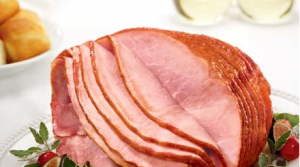 After a bit of back and forth, Thea adds that for dessert a giant chocolate cake and a cheesecake will make everyone feel like they’ve had an amazing treat. Just make it look opulent.
After a bit of back and forth, Thea adds that for dessert a giant chocolate cake and a cheesecake will make everyone feel like they’ve had an amazing treat. Just make it look opulent.
For my holiday parties, I add a spiral sliced ham, a basket of assorted breads, a variety of mustards, and a caviar pie. Here’s that recipe:
Mix 6 chopped, hard-cooked eggs with 3 T. of mayo
1 c. minced onion
8 oz. cream cheese mixed with 2/3 c. sour cream
Arrange in layers in a springform pan. Chill. Top with 2 small jars of caviar. Serve with crackers.
Thea and I wish you a very happy holiday.
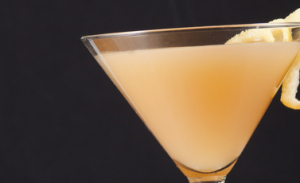 And if you’re not happy enough yet, may I suggest the Peartini?
And if you’re not happy enough yet, may I suggest the Peartini?
Pear vodka, St. Germain or other elderflower liqueur, the juice of a fresh lime. Shake with ice or pour over ice. And be careful. Be very careful. These are addictive.
Want to go fancier? Slice some pears, marinate in a bit of the vodka, and add to the drink.
December 16, 2014
An Unexpected Event
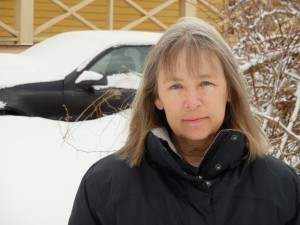 Hello again from Sarah Graves, writing to you from Eastport, Maine where I do still look like the photo at left, but the background doesn’t. The poor old car is there but the snow is gone, melted by inches of rain that soaked us all through but that at least did not have to be shoveled. And in December, if it comes out of the sky but doesn’t remain in the driveway or on the front walk afterwards, I’m all for it. A photogenic dusting is fine for the holidays but otherwise they can keep it on the ski hills, as far as I’m concerned.
Hello again from Sarah Graves, writing to you from Eastport, Maine where I do still look like the photo at left, but the background doesn’t. The poor old car is there but the snow is gone, melted by inches of rain that soaked us all through but that at least did not have to be shoveled. And in December, if it comes out of the sky but doesn’t remain in the driveway or on the front walk afterwards, I’m all for it. A photogenic dusting is fine for the holidays but otherwise they can keep it on the ski hills, as far as I’m concerned.
 The unexpected event was the collapse of the Eastport breakwater. As you may already know, it happened in the middle of the night, very suddenly. People nearby said the sound of a snowplow scraping on pavement woke them, the sound being tons of earth, steel, and wood falling. The caretaker on the schooner Ada Lore and his dog, asleep on the vessel directly adjacent to the collapse, barely escaped with their lives, and other boats were sunk or damaged as well.
The unexpected event was the collapse of the Eastport breakwater. As you may already know, it happened in the middle of the night, very suddenly. People nearby said the sound of a snowplow scraping on pavement woke them, the sound being tons of earth, steel, and wood falling. The caretaker on the schooner Ada Lore and his dog, asleep on the vessel directly adjacent to the collapse, barely escaped with their lives, and other boats were sunk or damaged as well.
 Here’s the scene from above. (Both of these photos are by Jim Lowe – thanks, Jim!) It could have been much worse since just a few hours later dozens of fishermen and their trucks would’ve been on the breakwater. But as it is, they’ll have to find other places for their boats — not an easy task. Having them out on moorings instead of in the boat basin means having to get to them by dinghy, a dangerous trip in winter when things are icy. And there’s no storm protection like the kind they used to get inside the breakwater.
Here’s the scene from above. (Both of these photos are by Jim Lowe – thanks, Jim!) It could have been much worse since just a few hours later dozens of fishermen and their trucks would’ve been on the breakwater. But as it is, they’ll have to find other places for their boats — not an easy task. Having them out on moorings instead of in the boat basin means having to get to them by dinghy, a dangerous trip in winter when things are icy. And there’s no storm protection like the kind they used to get inside the breakwater.
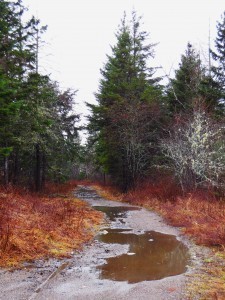 I wasn’t kidding about the rain. Fortunately, I have indoor work to do: the second book in the Lizzie Snow series, set in Aroostook County, Maine and called THE GIRLS SHE LEFT BEHIND, is in progress and I am chugging along on what I hope is the second-to-last rewrite. When I get to this stage I tend to remember without wanting to the theme music from “Murder, She Wrote,” that happy, tra-la-la tune that makes writing sound like such a pleasant occupation. The well-kept hands with their manicured nails moving lightly over the keyboard, the brisk, satisfied straightening of the finished pages…oh, how I despise that music. But I love Angela Lansbury, so there’s that. And even after all this time I do love the process, even when — especially when, actually — there’s no tra-la-la about it.
I wasn’t kidding about the rain. Fortunately, I have indoor work to do: the second book in the Lizzie Snow series, set in Aroostook County, Maine and called THE GIRLS SHE LEFT BEHIND, is in progress and I am chugging along on what I hope is the second-to-last rewrite. When I get to this stage I tend to remember without wanting to the theme music from “Murder, She Wrote,” that happy, tra-la-la tune that makes writing sound like such a pleasant occupation. The well-kept hands with their manicured nails moving lightly over the keyboard, the brisk, satisfied straightening of the finished pages…oh, how I despise that music. But I love Angela Lansbury, so there’s that. And even after all this time I do love the process, even when — especially when, actually — there’s no tra-la-la about it.
 The first book in the new series, WINTER AT THE DOOR, is due out January 6th, 2015 — i.e., Real Soon, Now — so I suppose I’d better say something about ex-Boston homicide detective Lizzie Snow’s maiden voyage. This one sends her to Bearkill, Maine where her long-missing niece may have been sighted, where her faithless but still devilishly attractive ex-lover Dylan Hudson, now a Maine state murder cop himself, tries luring her back into his arms, and where a series of supposed cop suicides may turn out to be something worse. Before it’s over, Lizzie’s going to find out just how different the mean streets of Boston are from the rural roads around Bearkill — and why taking an unscheduled bathroom break in a northern Maine swamp is a Really Bad Idea, at least until after there’s been at least one hard frost.
The first book in the new series, WINTER AT THE DOOR, is due out January 6th, 2015 — i.e., Real Soon, Now — so I suppose I’d better say something about ex-Boston homicide detective Lizzie Snow’s maiden voyage. This one sends her to Bearkill, Maine where her long-missing niece may have been sighted, where her faithless but still devilishly attractive ex-lover Dylan Hudson, now a Maine state murder cop himself, tries luring her back into his arms, and where a series of supposed cop suicides may turn out to be something worse. Before it’s over, Lizzie’s going to find out just how different the mean streets of Boston are from the rural roads around Bearkill — and why taking an unscheduled bathroom break in a northern Maine swamp is a Really Bad Idea, at least until after there’s been at least one hard frost.
December 15, 2014
Voice from the Past
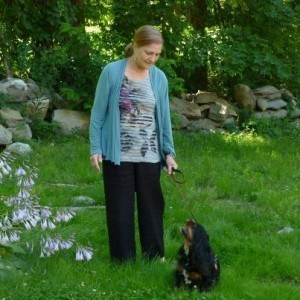 Dorothy Cannell with a tale of remembrance and caution: A couple of weeks ago I received an email from Norm, a member of a writers’ group to which I also belonged more than thirty years ago. I was delighted to hear from him. His reminiscences brought back a flood of heartwarming memories of our every other Thursday meetings covering a period of five or six years. We called ourselves the Shagbark Scribes. I’m not sure why, but someone suggested it and everyone agreed. For a long period we were all about enthusiastically supporting each other whether we were writing for the enjoyment of it or hoping to get published. Norm asked me if I remembered when the ‘rot’ set in and I wrote back to say I certainly did.
Dorothy Cannell with a tale of remembrance and caution: A couple of weeks ago I received an email from Norm, a member of a writers’ group to which I also belonged more than thirty years ago. I was delighted to hear from him. His reminiscences brought back a flood of heartwarming memories of our every other Thursday meetings covering a period of five or six years. We called ourselves the Shagbark Scribes. I’m not sure why, but someone suggested it and everyone agreed. For a long period we were all about enthusiastically supporting each other whether we were writing for the enjoyment of it or hoping to get published. Norm asked me if I remembered when the ‘rot’ set in and I wrote back to say I certainly did.
The group was founded by Ivan Sparling who taught creative writing at the local community college. 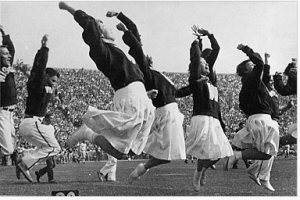 Our meetings were held in a classroom. He mailed invitations to likely people who had attended one or more of his classes, as I had done. At the end of the session I’d taken with him he’d told me I should write professionally. It was something I’d always wanted to do, but without his encouragement I’m not sure I’d done more than continue to think about it.
Our meetings were held in a classroom. He mailed invitations to likely people who had attended one or more of his classes, as I had done. At the end of the session I’d taken with him he’d told me I should write professionally. It was something I’d always wanted to do, but without his encouragement I’m not sure I’d done more than continue to think about it.
Joining the writing group set the seal on my commitment. It provided me with self-imposed deadlines – must complete something to read for each meeting. But of even more importance was the confidence boosting that came from being a cheering squad for each others work. Critiquing always came from the wellspring of desire for each of us to succeed. The Ivan Sparling approach. He was our core. His mentoring never heavy handed. He continued with us for several years after his retirement from teaching until his wife’s ill health necessitated his saying goodbye.
I’m not sure how much later the ‘rot’ and negative change that Norm mentioned occurred. It came in the person of a new member who had the status of being a published writer (something the rest of us had not yet achieved) having sold one story to a mystery magazine. Suddenly, he was our self-appointed leader, setting assignments rather than leaving us to bring whatever we wanted to read. And he proceeded more often than not, before anyone else opened their mouths, to shred our efforts. None of us balked. I suppose we were too dazzled by his ‘Success’, assuming he knew and we didn’t. One occasion springs to mind on my account. We had been instructed to write four pages that included a number of elements, the one I remember being a ghost. I had a ghost story in mind for sometime and set to work intent on getting part of it down, but became so caught up in it that I completed a nine page short story. Amazing for me, considering I’d never written one less than twenty.
I took it to the next meeting and when my turn came explained to our illustrious leader that I’d gone over the allotted amount but requested being allowed to read the first four pages. Permission was granted to real all nine. When I finished he eyed me over steepled fingers and uttered this pronouncement, “Dorothy you were instructed to write four pages, you wrote nine. Where there is no discipline there is no art.”
Silence from all sides. I shriveled. Went home, tossed the story in the back of a drawer and for at least a week considered never writing again. Forward a few years. By then I’d written three books. My agent phoned and asked if I’d like to write a ghost story for a magazine. I told her I had one, if I could find it.
A few weeks later my husband came home from work and I greeted him with a statement. “Remember that story – the one when I was told where there is no discipline there is no art? Well, there probably still is neither, but now there is $2,500!”
 The reason I’m passing along this bit of smugness is as a caution to fledgling writers to share their work only with people who wish them to succeed, not ones whose own egos demand setting themselves up as experts.
The reason I’m passing along this bit of smugness is as a caution to fledgling writers to share their work only with people who wish them to succeed, not ones whose own egos demand setting themselves up as experts.
Luckily there are far more of the other sort. I remember Norm with deep affection. Glad to hear he’s still writing.
Good luck.
Dorothy
A possible new publisher
Jayne Hitchcock here. I’m pretty disappointed with my publisher – my last book, True Crime Online, hasn’t been selling well and when it first came out, I did a flurry of radio interviews, but then that was all they did for publicity. I had to rely on my media contacts and contacting local media when I did speaking engagements or book signings (which I also scheduled myself) to promote it.
I was ready to give up on writing when I got an email from a publisher in Maryland in October. They wanted to know if I’d be interested in writing a book about online crimes. Would I?! Of course! Before replying, I did my research, found them to be reputable and with a good lineup of books and authors. I cautiously replied, talked to the publishing agent who had contacted me over the phone, wrote a proposal for a book about cyberbullying and sent that off to her, along with a copy of True Crime Online and my previous book, Net Crimes & Misdemeanors 2nd edition. She got back to me with what they provide for publicity/promotional events and I was pleasantly surprised at how invested they are in their authors.
I was psyched and posted on Facebook that I might be writing a new book. While most of my friends congratulated me and wished me luck, several (who mainly messaged me privately) asked if the publisher could look at their book as well.
What?!
I was a bit affronted. First, my books are mainly non-fiction and all of the people who contacted me had written a “novel.” They obviously didn’t know anything about the publishing business. I patiently explained to each one that there are different kinds of publishers and mine was strictly non-fiction looking to branch out into the technical/Internet areas. A couple of them actually got upset with me that I wouldn’t 1) Share the name of the publisher or 2) That I wouldn’t help them get published
Again, what?!
I patiently guided them to the Writer’s Digest web site and guide to literary agents and publishers, then let it go.
The publishing agent asked if I had five peers who could vouch for my expertise, so I set about contacting some Internet-savvy folks I know, some dealing with social media, and asked if they could be used as a reference for my new publisher. One was “too busy,” another wanted to know who the publisher, but I was hesitant to share. Is that wrong? But I did finally get five people who will vouch for me.
Now I have to sit and wait until the first of the year to see if my book proposal is accepted. I am thinking it will be, since they *did* invite me to provide one to them.
Some friends have been asking, online and in person, if I’ve written the book yet. I honestly almost laughed out loud. I had to explain that my proposal has to be accepted first, then a contract signed, then I will start writing, which probably won’t be until January or February at the earliest and again, only *if* it is accepted and approved. Then I have a year to complete the manuscript, then it goes to editing, proofing, etc. It probably won’t be out until 2016 if it all goes well. People are just boggled over that. They think getting a book published happens like magic!
Have any of you experienced this? Friends wanting you to help get them get published and not understanding anything about how it is really done? How do you handle it?
Cross your fingers for me and have a wonderful Christmas and Happy New Year!
December 12, 2014
Weekend Update: December 13-14, 2014
 Next week at Maine Crime Writers there will be posts by Jayne Hitchcock (Monday), Dorothy Cannell (Tuesday), Sarah Graves (Wednesday), and Kate Flora (Thursday), and a special post on Holiday reading on Friday.
Next week at Maine Crime Writers there will be posts by Jayne Hitchcock (Monday), Dorothy Cannell (Tuesday), Sarah Graves (Wednesday), and Kate Flora (Thursday), and a special post on Holiday reading on Friday.
In the news department, here’s what’s happening with some of us who blog regularly at Maine Crime Writers:
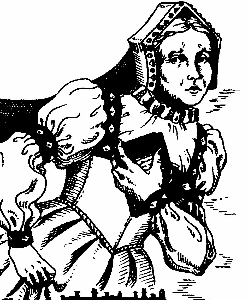 from Kathy Lynn Emerson/Kaitlyn Dunnett: As special holiday treat for our readers, here’s the link to a Christmas story I wrote several years ago. It features characters from my Face Down series and is set in Elizabethan England. Click here to read Lady Appleton and the Yuletide Hogglers and see how the holidays were celebrated way back in the sixteenth century. Enjoy!
from Kathy Lynn Emerson/Kaitlyn Dunnett: As special holiday treat for our readers, here’s the link to a Christmas story I wrote several years ago. It features characters from my Face Down series and is set in Elizabethan England. Click here to read Lady Appleton and the Yuletide Hogglers and see how the holidays were celebrated way back in the sixteenth century. Enjoy!
An invitation to readers of this blog: Do you have news relating to Maine, Crime, or Writing? We’d love to hear from you. Just comment below to share. Don’t forget that comments are entered for a chance to win our wonderful basket of books and the very special moose and lobster cookie cutters.
And a reminder: If your library, school, or organization is looking for a speaker, we are often available to talk about the writing process, research, where we get our ideas, and other mysteries of the business. Contact Kate Flora: mailto: kateflora@gmail.com
December 11, 2014
Thoughts as 2014 winds up

Scenic spot on the Airline that generated a story which ended up in a Level Best Anthology
While there are three weeks remaining in 2014, this is my last scheduled post for the year at MCW. Looking back, it has been an interesting one to say the least. I became a grandfather to the neatest, happiest kid imaginable. Piper made Thanksgiving the best one ever and as I reflected upon it, I realized how different generations in my family are than previous ones. I remember my four grandparents but there wasn’t much in the way of warmth, involvement or overt affection. When we kids got older, the times we and our parents spent doing things together got fewer and fewer as well.
Contrast this with 2014. Everyone was happy to hold Piper and play peek-a-boo and similar games, She’s had at least 500 books read to her and it was a hoot watching her mother introduce her to slivers of pumpkin pie. The following night, Beth and I took our adult daughters to see Mockingjay. Going to see Hunger Games, Harry Potter, Hobbit and similar movies is part of out family tradition now and something that seldom happened when I was a young adult.
This was also the year I set a firm date to retire from the library profession and shared it with the folks who oversee the library as well as my patrons. June 1, 2015 will be my last day. That doesn’t mean I’m vanishing from the profession completely (I plan to be a cataloging volunteer a day a week for members of our library consortium), but I’m looking forward to the freedom to stay in bed, not shave and be completely indolent on days when the mood strikes me.
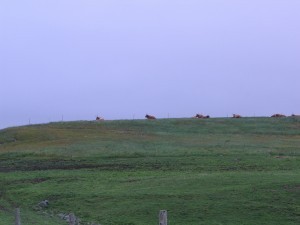
Imagine meeting these in a dense fog
I had another bout with depression in the fall and let it get so strong that my ability to write, aside from blogging and book reviews, completely died. Whether it will return or not is still debatable, but losing it helped me focus on just how many book reviews I did and published this year. I’ve read about 225 books and reviewed more than 175. Pretty much every review was posted on Amazon and Goodreads, with most also being posted on the Central Maine Librarian’s review blog and recently to Edelweis. I pretty much write only positive ones and am fortunate in that there is an amazing abundance of really interesting and pretty immersive YA books being published. The response from other readers, authors and fellow librarians tells me that writing these is helpful to plenty of people. In fact I have a separate book case at the library that holds the YA books I’ve read and a dozen or so patrons hit it each time they come to the library.
If and when the ability to write returns, near the top of my gotta do list is a book or very long article I’m going to call Building the Best Small Library Possible and how you can do it too. I’m going to describe the things I and my extremely capable cadre of volunteers have come up with, as well as the mistakes we made and what we learned from them. No matter how long you’re in this profession, there are new things to try that often produce bigger benefits than you imagined they might. For example, we split out our Christian fiction into a separate location after listening to several patrons complain that they had to spend an awful lot of time looking through the shelves to find any.
It wasn’t long after that when we did the same thing with paranormal romance. That was extremely successful for patrons at other libraries when they were looking for PNR titles to borrow because we added the prefix of PNR to all the call numbers, making it easy to figure out what we thought fit. When we ran out of room in our DVD room a couple months ago, we weeded dead stuff from adult nonfiction and created room so we could put all the horror movies together. Not only did we get more room in the big movie room, but a lot of patrons told us the new sub-collection was a great idea. I know a lot of librarians would cringe at having a significant number of slasher and monster flicks in their collection, let alone feature a spot where they were all together, but it really did work well.
The other ‘niche’ market we’re really up there with is audio books on CD. We couldn’t afford to buy into the statewide down-loadable audio collection and we didn’t have a lot of Kindle or similar e-reader owners in Hartland. However, we still had plenty of people who liked to listen to audio books while driving to work, exercising or working around the house. Fortunately, my daughter Lisa hits book sales at fancy city libraries where she can get really good ones for a buck, sometimes less. Coupled with ones I review for School Library Journal or trade for on Paperback Swap, we have arguably the biggest collection of books on CD in Maine and our patrons never have to hunt very hard for something new and different.
The next challenge is going to be starting the process of disengagement while making sure the library is still moving forward. I am pretty certain I have one or more great candidates in the wings who can step in and take over. Will they run it as I have? Of course not, but they will have ideas and insights that, in many cases, will be even better than mine and that’s the way it should be.

One of Baxter State Park’s many residents
I will leave you with two more reviews of books that won’t come out until May of 2015. One advantage of being a prolific reader/reviewer is that publishers are happy to give you access to digital review copies so they can generate some advance publicity. If you remember my last post where I highlighted Brian Katcher, you know I was really eager to read his next book. Well, after uploading a bunch of reviews to Edelweis last week, lo and behold, I found his book was available for download. I had the best time reading and reviewing it. Likewise for another great YA book about a high school senior who has paranoid schizophrenia. Here are those reviews. I’ll see you all again in 2015.
The Improbable Theory of Ana and Zak, Katherine Tegen Books, Pub. Date May, 2015. Digital advance reading copy courtesy of Edelweis. Can uptight and laid back co-exist? Zak, AKA Duke, appears to be ultra-cool and unruffled on the outside, but he’s really sad and a bit hurting on the inside. He’s still missing his dad who died of cancer a few years ago and he’s really uncomfortable around his stepfather, Roger, in part because of how fast he and Zak’s mom got married after they met. Zak’s really into role playing and all the affiliated stuff that comes with it. He’s totally pumped because next weekend he’ll be in his element at Washingcon, the highlight of his year.
Ana is about as far personality-wise from Zak as one could get. She’s ultra-serious, driven (in large part by her parents’ rigid expectations to have a perfect daughter), is locked into a perpetually tight schedule and has a responsibility bump the size of Guatemala. She’s stressing out about the quiz bowl competition next weekend. She feels full responsibility for the team’s success, even to the point of having convinced her parents to let her precocious younger brother, Clayton, be on the team.
Two completely different personalities and two completely different sets of weekend plans are about to be dumped into the same bowl of life and get thoroughly mixed together. A recipe for disaster on the surface, but much more fun and interesting underneath.
When Mrs. Brinkham, the health teacher and adviser to the quiz bowl team, has Zak step into her office, his life is about to get a lot more interesting. She confronts him with the fact that he downloaded a Wikipedia article and copied it almost word for word when submitting it as his health paper. She gives him a choice: Be an alternate on the quiz team and rewrite the paper for a passing grade, or fail completely and have to take health over again in the summer.
It’s a tough choice for Zak. The Con is his one happy event now that Dad is gone, but he really wants to go to the community college next fall and not passing health will kill his chance to do so. He agrees to her terms.
Ana is less than pleased with him as an alternate and becomes even more so when Clayton starts getting really interested in Zak’s stories about previous Cons. She thaws a little when Zak saves the team from defeat in an early round, but when Clayton hops into a taxi later that evening to see what the Con is all about, she freaks completely. If her parents get wind of what her brother is up to, she’s sure all the blame will fall on her head.
When Zak agrees to help find her brother, they take off in another taxi and what happens over the next several hours is alternately scary and hilarious. Ana has no clue what she’s about to encounter, nor does she have any idea how much popularity Zak has with the folks who go to Cons.
The cast of characters Brian creates to populate the Con, the language, the events and the misadventures will be familiar to anyone who has attended one or more of these events. He gets it all right and, coupled with his ability to make both Zak and Ana appealing and ever more attracted to each other as the night progresses, makes this a great fun and feel-good read. There’s nothing in the book that might deter tweens from reading it, so this is going to be a dandy addition to any library, public or school. I’d love to see it as a movie down the road.
Made You Up by Francesca Zappia, Greenwillow Books, to be published in May, 2015. When she was seven, Alexandria freed the lobsters at the supermarket. She was helped by a mysterious boy who had bright blue eyes and smelled like pond water. He agreed to be her friend after helping her, but he vanished.
Ten years later, Alex is struggling with reality. She has paranoid schizophrenia and has to rely on medication, obsessive and constant perimeter checks and her trusty digital camera to cope. She takes lots and lots of pictures that she looks at later to help determine what’s real and what are visual hallucinations.
She’s starting at a new school, having painted the word communists in big red letters on the gym floor at her old high school. Hopeful that she’ll fit in and maybe find some real happiness at the new school, she’s been working at Finnegan’s a restaurant all summer and has made friends with Tucker who has been filling her in on East Shoal High, her new school. When Miles comes in for his usual cheeseburger and fries, Tucker hints vaguely that he’s not normal and has Alex wait on him. The mystery boy barely talks to her, but when he does look up, his startling blue eyes pull Alex back to that day ten years ago and she’s filled with an array of emotions. Could it be that the boy she remembers really does exist, despite her mother telling her most of what she remembers that day wasn’t real?
When she starts school, Miles is running the club that gets all the kids who have to do community service. Alex has to participate because of her paint job at the other school. She’s a bit scared, but far more intrigued by Miles who is beyond smart, has a slight German accent and apparently hires out to do really strange stuff for other students.
Both of them, along with Tucker, are curious about the principal’s obsession with the gym scoreboard that was donated in honor of a girl more than twenty years before. When she returned five years after graduating, the scoreboard fell, killing her. They suspect there’s an odd link between the principal, the scoreboard and Celia, a cheerleader who has a thing for Miles and whose mother was in the same class as the girl the scoreboard killed.
This could have easily turned into a typical teen romance, but the author moved it into far more interesting directions and I am incredibly impressed with how she built Alexandria’s personality, especially her battle to distinguish reality from her illness. Having worked in inpatient mental health for more than 25 years, she got this aspect as right as anyone possibly could. So much so, that there are several completely gut-wrenching moments in the final third of the book that are directly related to her illness.
Miles is also well crafted and has some intriguing issues of his own. He’s both brilliant and terribly vulnerable, but keeps that latter piece hidden from everyone until Alex manages to get inside his shell.
This is a love story, a mystery and an excellent look at two teens trying to perceive the world through flawed lenses. While there is a fair amount of profanity and some violence, neither should deter any library from adding this to their collection. It would be particularly good for libraries who care about offering insights into teen mental heath issues. On a final note, there are sufficient mystery elements for this to be considered as a YA Edgar candidate.
The Dreaded Synopsis
It has been my recent pleasure to speak with young writers who all want to be the next somebody, and who all seem to be plagued with the same common problem; How to write a good @*^%*#@ SYNOPSIS. Wanting to be the next somebody is a problem in itself, and something agents and publishers never want to hear. The kiss of death is telling an agent your book is the next DaVinci Code or Harry Potter. Don’t do it. The synopsis, however, is something I might be able to help with a bit.
Most tell me they find it easier to write the book than the synopsis. I shared this problem for a very long time as well. Writing my novel was a breeze compared to the dreaded synopsis. This is true, I told the young writers, because with your book you have unlimited space and words to tell your story. With a synopsis, you have three paragraphs and no more at most to say what you said in seventy-five thousand or more words.
The trick is to make the synopsis intriguing enough for an agent or publisher to want to read the entire book. This trick is about as easy as eating tomato soup with a fork. However, I will share some tips, tricks and common sense things I have learned from studying successful synopsis writing of others, research and good old fashion idea sharing from peers. There is no magic here, and you may still struggle along the way, but if you follow this guide, you will eventually get there.
Let’s start with the first of three paragraphs. Begin this paragraph by introducing the two main characters, the protagonist and the antagonists. (That’s the good guy/gal, and the bad guy/gal to the rest of the world.) Next, in one sentence explain what happened to get the ball rolling in your story. Then, again try to keep it to one sentence, tell where they are and when this is happening.
In the second paragraph, explain what your protagonist (good guy/gal person) and your antagonist (bad guy/gal person) are planning to do. Tell how, where and when they are going to do it, and, of course, why. Do Not mention any other characters from your story unless it is impossible not to.
The third paragraph tells how the story ends. Tie it back to the what happened moment in the first paragraph. Never leave your synopsis as a mystery. Agents and publishers want to know how the story ends. Tell them. They hate guessing games and don’t have the time to figure out your ending, so don’t be shy and tell them.
Keep in mind that the synopsis is a summarization of the book that has already been written, so don’t rewrite the book as a synopsis. Incorporate the following elements into the three short paragraphs I just outlined.
The Hero.
The Situation.
The Goal.
The Villain.
The Disaster.
The Solution.
If this sounds like a Hollywood movie poster, it is. The people who write Hollywood movie posters are experts at writing a synopsis. In my experience, many times the poster has been better than the movie, but that’s another matter entirely.
Last bit of advice. Never use the first draft of your synopsis no matter how good you may think it is. Read it, read it again, and then make it better. I find that after I have tweaked a synopsis at least ten times, it is finally ready to be shown.
Practice, as they say, makes perfect. In the case of synopsis writing, this is very true. In the case of eating tomato soup with a fork, not so much.
Al Lamanda is the author of the Edgar Award nominated mystery novel Sunset. The sequel titled Sunrise was voted best crime novel of 2014 by the Maine Writers and Publishers Alliance. The third installment titled First Light was released in July, 2014. The latest This Side of Midnight will be released in the summer of 2015.
December 9, 2014
Fifteen Things You Probably Don’t Know About Me
Hi. Barb Ross here. Madly getting ready for Christmas.
Taking off from Lea Wait’s recent post, here are 15 things you probably don’t know about me.
 1) Zsa Zsa Gabor once called me “a blond bumshell.” I was eighteen months old at the time.
1) Zsa Zsa Gabor once called me “a blond bumshell.” I was eighteen months old at the time.
2) I never graduated from high school. I spent my senior year of high school in Colombia, South America as a Rotary Exchange student. All I had to do was pass English there in order to graduate from my stateside high school. But at my Colombian school, they were doing sentencing diagramming based on Noam Chomsky’s work in syntactic trees. I never did get the hang of it and flunked English. I marched in my US high school graduation, and when I got to the podium, I got a beautiful case with an index card in it that said I would get a high school diploma once I passed two semesters of freshman English in college. But by the next spring…
3) The Wyoming Valley where I lived in Pennsylvania was devastated by a flood following Hurricane Agnes. The records at my high school were destroyed and I never got that high school diploma.
 4) Our house was heavily damaged in the Agnes flood as well. I was away waitressing and living at a resort in the Poconos. My parents and brother were evacuated, and then spent weeks living without running water, electricity or refrigeration as they mucked out our house which had had six feet of water on the first floor and extensive foundation damage. I came home toward the end of the summer. I often think the theme in the Maine Clambake Mysteries where various characters tell Julia she wasn’t there enough during her father’s fatal illness (and Julia feels this acutely, too) comes from this experience.
4) Our house was heavily damaged in the Agnes flood as well. I was away waitressing and living at a resort in the Poconos. My parents and brother were evacuated, and then spent weeks living without running water, electricity or refrigeration as they mucked out our house which had had six feet of water on the first floor and extensive foundation damage. I came home toward the end of the summer. I often think the theme in the Maine Clambake Mysteries where various characters tell Julia she wasn’t there enough during her father’s fatal illness (and Julia feels this acutely, too) comes from this experience.
5) A few years later, my parents bought the house they were evacuated to.
 6) I lived in Montclair, New Jersey from age four to age nine. My next door neighbor my final year there was Joe Walsh, famed guitarist with the James Gang and the Eagles. He was sixteen and, in this nine-year-old’s opinion, absolutely dreamy. He played his first paying gig in a tuxedo he borrowed from my dad.
6) I lived in Montclair, New Jersey from age four to age nine. My next door neighbor my final year there was Joe Walsh, famed guitarist with the James Gang and the Eagles. He was sixteen and, in this nine-year-old’s opinion, absolutely dreamy. He played his first paying gig in a tuxedo he borrowed from my dad.
7) One Sunday in fourth grade, I ran away from home. I didn’t have any clean knee socks to wear to Sunday school. My mother pointed out it was because I never put my clothes in the hamper and made me wear babyish ankle socks. The whole experience was so humiliating that as soon as I got home, I took off. I walked for miles and miles and miles, fantasizing about raising myself in the woods before it occurred to me that a) I didn’t have a plan, and b) I had no idea where I was. So I turned around and walked miles and miles until I finally ended up in a neighborhood I recognized and could make my way home. It was evening by the time I got home and my parents were worried out of their minds and so furious they could barely speak to me. As I sat alone, exiled, in the back yard, Joe Walsh gave me some of the best advice I’ve ever gotten. Pointing out that no one knew if I’d been kidnapped or in an accident or what, he said, “Always leave a note.”
 8) In high school I attended a meeting with James Michener who came to town speaking on behalf of the anti-war movement. At the end of the meeting he took my hands, looked deeply into my eyes and said, “Good luck with your writing.” I had never told him I wanted to be a writer.
8) In high school I attended a meeting with James Michener who came to town speaking on behalf of the anti-war movement. At the end of the meeting he took my hands, looked deeply into my eyes and said, “Good luck with your writing.” I had never told him I wanted to be a writer.
 9) At my interview at the University of Pennsylvania, I asked the admissions officer about my chances of getting in early admission. “Oh,” he said, casually, “you’ll probably get in. We like to accept a few dumb blondes to round out the class.” I went there anyway, which astounds me. My grown-up self realizes he was joking, something my teen-aged self was too insecure to see, but I often wonder what would happen if an admissions officer said something like that today.
9) At my interview at the University of Pennsylvania, I asked the admissions officer about my chances of getting in early admission. “Oh,” he said, casually, “you’ll probably get in. We like to accept a few dumb blondes to round out the class.” I went there anyway, which astounds me. My grown-up self realizes he was joking, something my teen-aged self was too insecure to see, but I often wonder what would happen if an admissions officer said something like that today.
10) The summer between my junior and senior years in college, at Herb McCarthy’s Bowden Square, I waited on Truman Capote at lunch every Monday. I wrote about that for the blog .
11) I have one brother, and my brother and I each have a boy and a girl. On the other hand, my father was an only child, and both of my grandfathers were only children.
12) My grandfather, Clarence McKim, won a scholarship to Princeton in 1921, where he was a track star and captain of the football team (he was about 5’6″ and maybe 140 pounds in his playing days). In fact, since now they run the 100 meter dash, some of his 100 yard dash records still stand.
13) All four of my grandparents are college graduates, including both my grandmothers, which I think at my age is more unusual. My family has a long tradition of educating men and women equally.
 14) One summer night we got a call at my grandparents house in Water Mill, NY from CBS news, asking if it was true there are been “a murder in our compound.” Thinking it was a prank, my grandmother hung up. But then my grandfather got curious and called CBS back, and they were indeed tracking down such a murder. Apparently, our neighbor, who’s claim to fame was that we was Salvador Dali’s gem cutter, was “dining out all over New York,” telling people he’d found a body in our living room. We never did figure out the story behind this story.
14) One summer night we got a call at my grandparents house in Water Mill, NY from CBS news, asking if it was true there are been “a murder in our compound.” Thinking it was a prank, my grandmother hung up. But then my grandfather got curious and called CBS back, and they were indeed tracking down such a murder. Apparently, our neighbor, who’s claim to fame was that we was Salvador Dali’s gem cutter, was “dining out all over New York,” telling people he’d found a body in our living room. We never did figure out the story behind this story.
15) I was a co-founder and Chief Operating Officer of WebCT, a company that was among the creators of a category of software called “course management systems” for higher education.
December 8, 2014
Christmas at Lea’s House
I’m Lea Wait, and for many years I had (among other collections) many, many Santa Clauses. Since Christmas was, and still is, my very favorite time of year, my daughters and I would start decorating on the Saturday or Sunday after Thanksgiving. The Santas would be unpacked to appear on the mantel, on table tops, and on walls.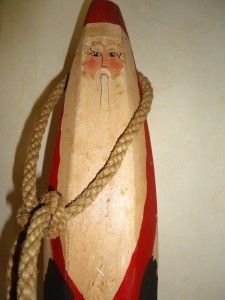
When my family was growing up we always had two Christmas trees — one large, real, one that would go up and be decorated a day or two before Christmas, and one small tree, hung with small ornaments, that was artificial, and would go up when the Santas did.
In those days each year I hosted a large party (150-200 people) on the first Sunday in December for single adoptive parents, their children, and prospective single parents. (The first prospective single dad who arrived received the honor of being ushered upstairs to don the Santa suit I had waiting. Many years later I ran into a woman who’d been one of my young guests. She told me that for years she’d believed Santa lived at my house!) The adoptive parent party would be followed by a luncheon (yes, catered) for those in my department at AT&T, and finally, by a special

1930s Coca Cola Advertising Santa
Christmas Eve party for family and close friends. (Catered by me.)
Today, instead of hosting family and extended family and friends, I spend Christmas with my husband, who, I’ll admit, is a bit of a Grinch. No, the holidays aren’t the same. Although I love being with him, I do miss the excitement and joy of past Christmases.
I’ve even divested some of the Santas, although some that are left I’ve pictured here. I also still have that small artificial tree (it actually was – 45 years ago – the top of an artificial tree I used as a prop in a Christmas safety film I produced) I first hung in my single-gal apartment in Greenwich Village. And I still hang stockings on the mantelpiece, treasure every Christmas card that comes to remind me of family and friends not in Maine, and plan special food for the holidays.

Tinsel Painting done by my mother
Life changes. But I still love Christmas, even toned down. I look for gifts for children and grandchildren all year, and love wrapping them up and sending them, imagining how they’ll be received. I love the special food we have Christmas morning (filet mignon and mushrooms and champagne). I love Christmas carols and sappy Christmas movies and the Christmas cards and packages that arrive at our door, reminding us of loved ones celebrating in other places.
I loved writing my latest Shadows mystery (Shadows on a Maine Christmas) because it felt as though I was celebrating with Maggie and Will and Aunt Nettie. (I even gave them my special Christmas breakfast.)
And, now that I’m a writer, I also have the joy of knowing that, through my books, I’ll be under many Christmas trees this year.
I still love Christmas! May you and your loved ones have a special one, full of memories in the making. 
December 7, 2014
CHRISTMAS CUSTOMS — A SHOE-IN
Susan Vaughan here. I admit it, the title’s a bad pun, but you’ll see shortly why I couldn’t resist.
Christmas customs around the world differ in strange and bizarre ways. In the U.S., Canada, and Great Britain, we’re familiar with the tradition of hanging stockings for Santa to fill. In many other places, footwear also plays a role, but usually not stockings.
Before going to bed, children in France put their shoes by the fireplace. They hope that Père Noel will put small gifts inside. France’s Santa also hangs small toys, nuts, and fruits on the tree. In Holland, children fill their shoes with hay and a carrot for the horse of Sintirklass, while Hungarian children shine their shoes before putting them near the door or a windowsill.In Italy, children leave their shoes out the night before Epiphany, January 5, for La Befana the good witch to fill with treats and gifts. The custom appears to date from when children wore wooden peasant shoes but not why or how it began.

La Befana
Iceland has many traditions for celebrating the holiday. I won’t go into the history, but nowadays thirteen Santa Clauses, called jólasveinar, or “Yuletide Lads,” come to each town bearing gifts, candy, and mischief. The first jólasveinn arrives thirteen days before Christmas and then the others follow, one each day. A special custom is for children to set a shoe in the window from December 12 until Christmas Eve. If they have been good, one of the “Santas” leaves a gift, but bad children receive not a lump of coal but a potato. After Christmas, the Yuletide Lads leave as they arrived, one each day, making the Icelandic Christmas season last twenty-six days.
The Czech Republic has a wealth of Christmas customs and superstitions, but none for filling children’s shoes or stockings. Instead, I found Christmas customs that offer marriage hope to girls in the family. On Christmas Day, an unmarried girl can stand with her back to the door and throw a shoe over her shoulder. If the shoe lands with the toe pointing to the door, she will be married within the year.
Because eighty percent of the population in the Philippines is Christian, Christmas is huge there. For centuries, the bearers of gifts for children have been not Santa but the Three Kings. Brightly polished shoes and clean socks are left on windowsills, for the Kings to fill with gifts as they pass by on their way to Bethlehem. Some children leave straw or dry grass for the camels; if these are gone in the morning, the camels must have been very hungry. Epiphany, the “Feast of the Three Kings,” marks the end of the Christmas celebration.
A very different kind of footwear is prominent in another warm country, Venezuela. In the capital city, Caracas, before young children go to bed on Christmas Eve, they tie one end of a string to their big toe, leaving the other end outside their bedroom window. On Christmas morning, streets are closed off to cars until 8 a.m. for people to roller skate to the early morning mass, and the custom is to tug on any strings still hanging from windows. Ouch. That one could be painful.
I’ll leave you with wishes for a Happy Holiday and with questions for which I do not have answers. I imagine the tradition of filling shoes and stockings with treats and small gifts spread around the world with Christianity, but how did this custom start? Why do shoes and stockings play such a prominent role in Christmas celebrations?
*** My Task Force Eagle ebook ONCE BURNED is only 99 cents Dec. 18-22 on Amazon. You can find more information about my books at www.susanvaughan.com.
Lea Wait's Blog
- Lea Wait's profile
- 509 followers


